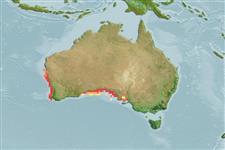Common names from other countries
Elasmobranchii (sharks and rays) >
Orectolobiformes (Carpet sharks) >
Orectolobidae (Carpet or nurse sharks)
Etymology: Sutorectus: sutor, Latin fopr cobbler, referring to Cobbler Carpet Shark or Cobbler Wobbegong, its local name in South and Western Australia; orektos (Gr.), stretched out, presumably referring to its long nasal barbels and/ or alluding to its affinity with the closely related genus Orectolobus. (See ETYFish); tentaculatus: -atus (L.), provided with: tentacule (L.), feeler, i.e., small tentacle, referring to unbranched dermal lobes (nasal barbels) on head (“tentaculis cutaneis simplicibus”). (See ETYFish).
More on author: Peters.
Environment: milieu / climate zone / depth range / distribution range
Ecology
Marine; reef-associated; depth range 0 - 35 m (Ref. 106604). Temperate; 26°S - 35°S, 113°E - 139°E (Ref. 54916)
Eastern Indian Ocean: Australia.
Length at first maturity / Size / Weight / Age
Maturity: Lm ?, range 65 - ? cm
Max length : 92.0 cm TL male/unsexed; (Ref. 247)
Found inshore on the continental shelf (Ref. 6871). Frequents rocky and coral reef areas. Biology almost unknown. Ovoviviparous (Ref. 6871). May possibly grow to 200 or 300 cm TL.
Life cycle and mating behavior
Maturity | Reproduction | Spawning | Eggs | Fecundity | Larvae
Ovoviviparous, embryos feed solely on yolk (Ref. 50449).
Compagno, L.J.V., 1984. FAO Species Catalogue. Vol. 4. Sharks of the world. An annotated and illustrated catalogue of shark species known to date. Part 1 - Hexanchiformes to Lamniformes. FAO Fish. Synop. 125(4/1):1-249. Rome, FAO. (Ref. 247)
IUCN Red List Status (Ref. 130435)
CITES (Ref. 128078)
Not Evaluated
Threat to humans
Traumatogenic
Human uses
Fisheries: of no interest
More information
Age/SizeGrowthLength-weightLength-lengthLength-frequenciesMorphometricsMorphologyLarvaeLarval dynamicsRecruitmentAbundance
ReferencesAquacultureAquaculture profileStrainsGeneticsElectrophoresesHeritabilityDiseasesProcessingMass conversion
Tools
Special reports
Download XML
Internet sources
Estimates based on models
Preferred temperature (Ref.
115969): 16.9 - 22.5, mean 18.2 (based on 64 cells).
Phylogenetic diversity index (Ref.
82804): PD
50 = 1.0002 [Uniqueness, from 0.5 = low to 2.0 = high].
Bayesian length-weight: a=0.00389 (0.00180 - 0.00842), b=3.12 (2.94 - 3.30), in cm Total Length, based on all LWR estimates for this body shape (Ref.
93245).
Trophic level (Ref.
69278): 3.8 ±0.6 se; based on size and trophs of closest relatives
Resilience (Ref.
120179): Low, minimum population doubling time 4.5 - 14 years (Fec assumed to be <100).
Fishing Vulnerability (Ref.
59153): High vulnerability (57 of 100).
